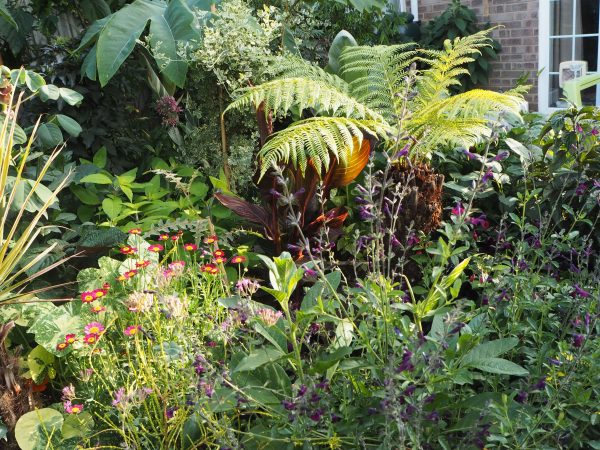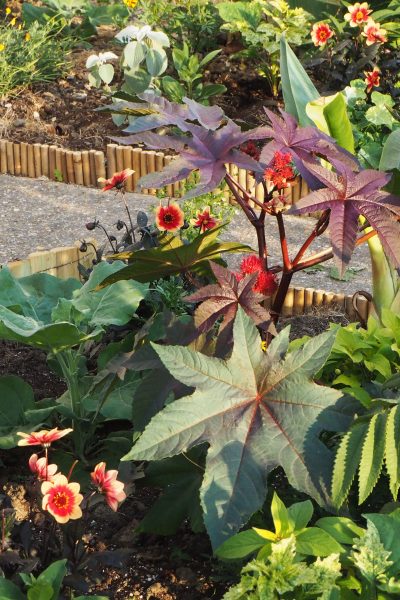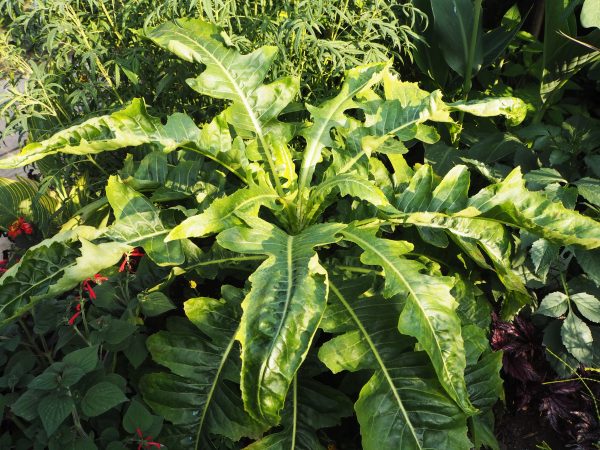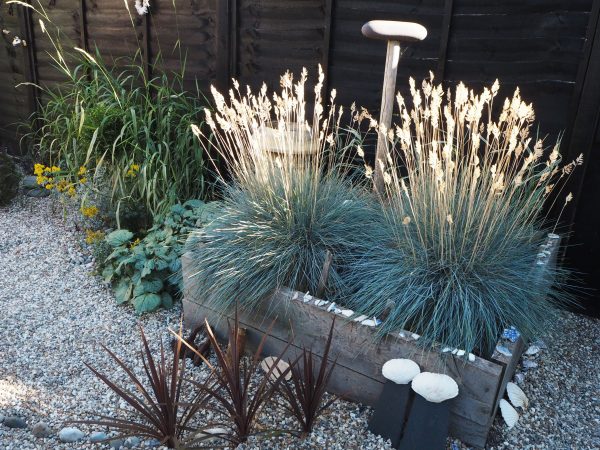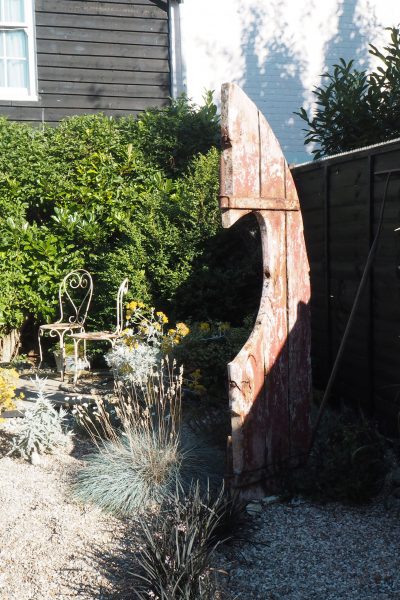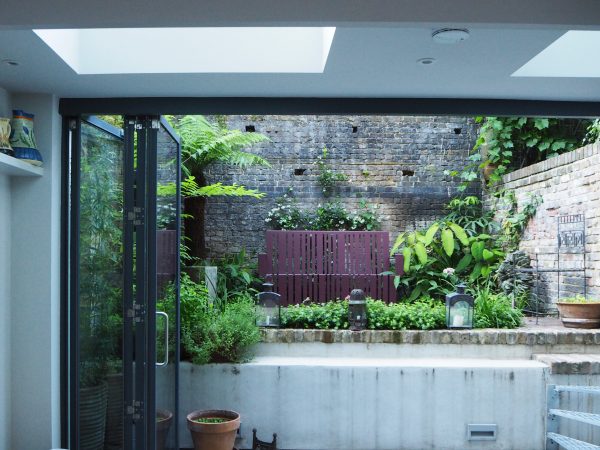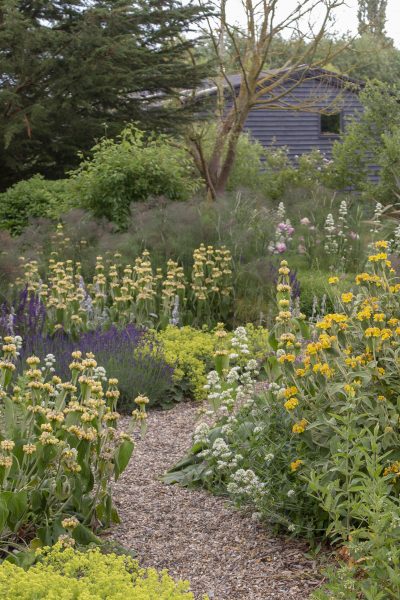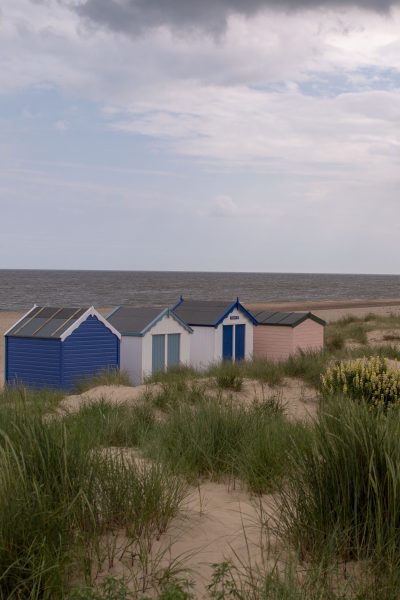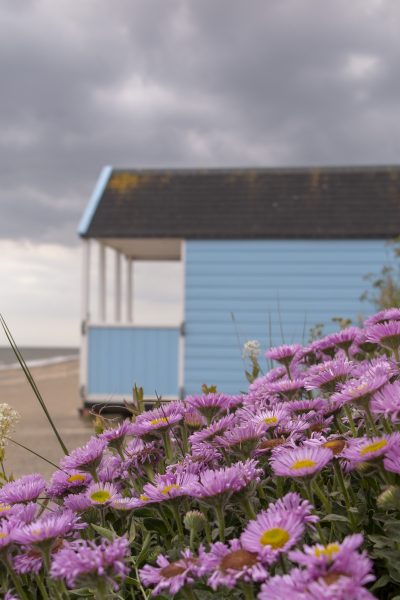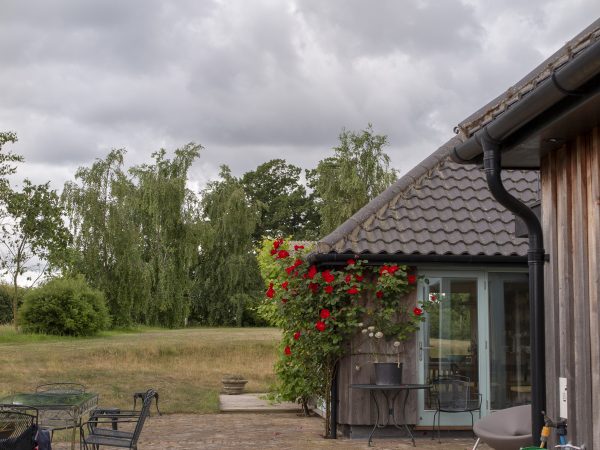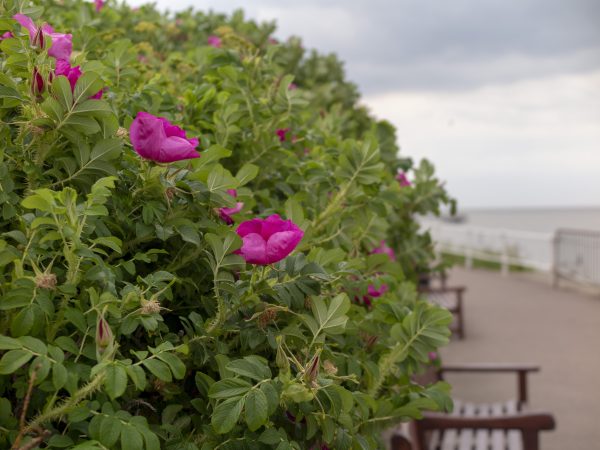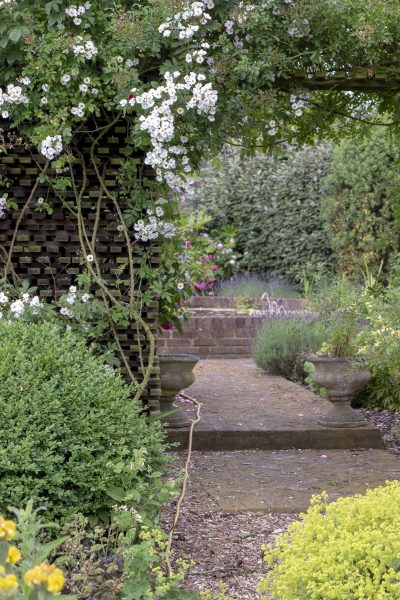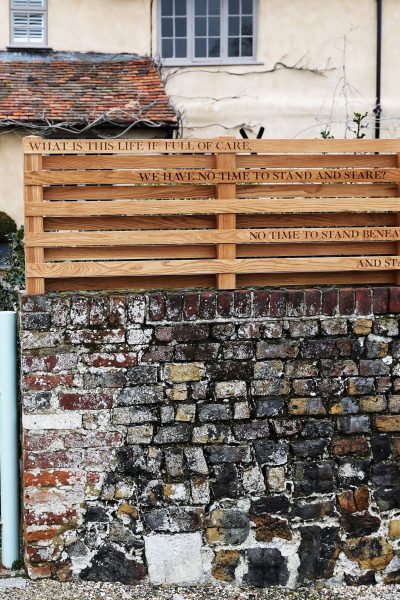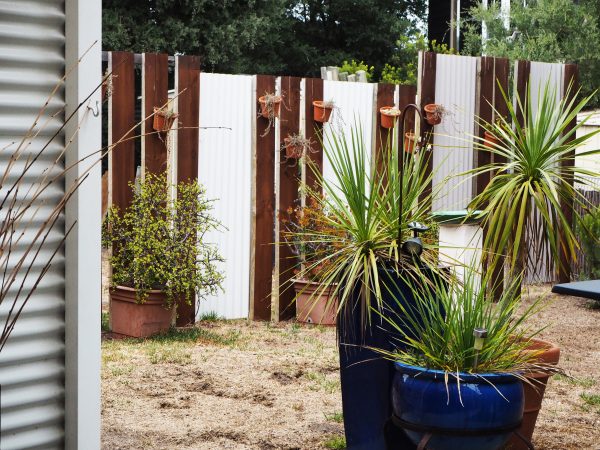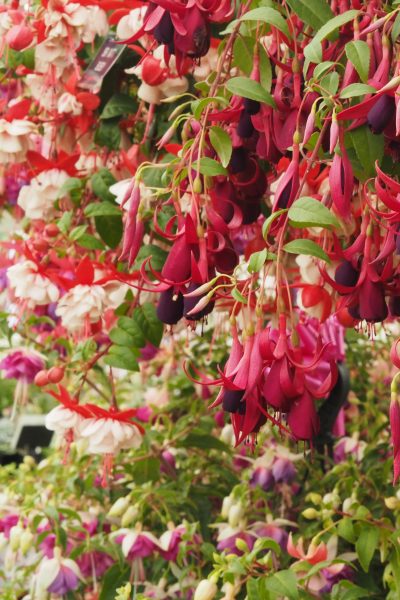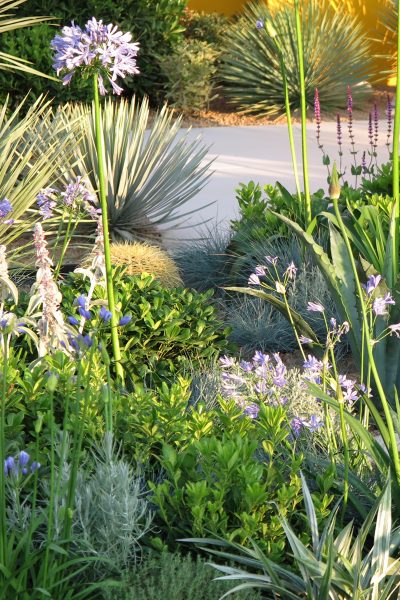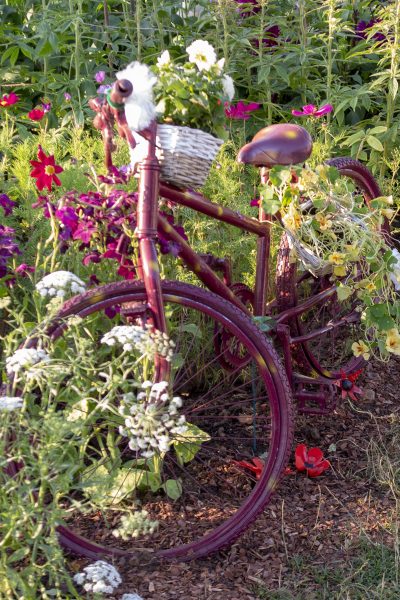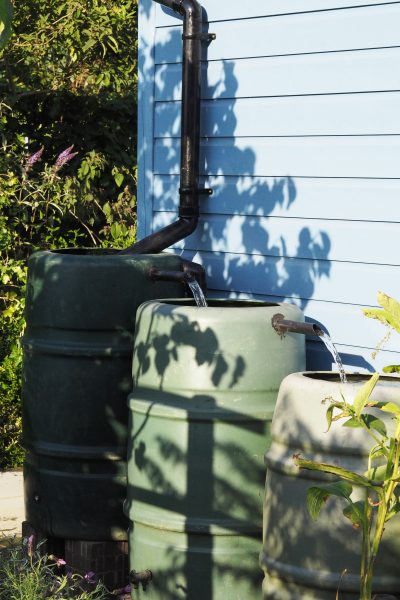I’ve just visited a dramatically gorgeous garden for entertaining – and it’s also a plant-lover’s heaven.

Dan Cooper’s lush and jungly garden for entertaining. It has shelter from the seaside breezes, scented plants and an outdoor kitchen. The variegated leaf in the foreground is Coleus ‘Henna’ and it changes colour depending how much sunlight it gets.
The garden belongs to Dan Cooper, who blogs about urban and coastal gardening in his blog, The Frustrated Gardener. He opens the garden once a year, on the 4th and 5th of August for the NGS.

Dan Cooper’s writing desk – an inspiring area for a garden blogger to write in.
Two gardens for entertaining
And while many of us have a front garden and a back garden, Dan’s home is unusual – it has two side gardens. He recently bought the house next door and knocked through.
Broadstairs is a charming historic town, with houses and streets growing higgeldy-piggeldy up from a beautiful sweeping beach. A quirk of architecture means that both of Dan’s gardens are tucked away around a separate entrance door on either side.

Viking Bay in Broadstairs – the historic houses rise up the hill in a variety of sizes and eras.
One garden has an outdoor kitchen and a large generous dining table.
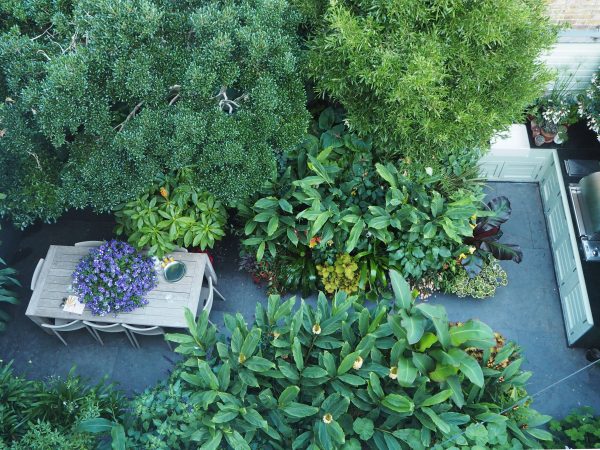
Overhead view of the dining table and outdoor kitchen. The tree on the top right is Phillyrea latifolia and the one on the left is a narrow-leafed bay tree (Laurus nobilis ‘Angustifolia).
The other is called ‘the Gin-and-Tonic garden’ because it has a small table and chairs for enjoying an evening drink.

Dan’s Gin-and-tonic Garden – a perfect place to enjoy an evening drink. The red rose is ‘Dublin Bay’ and the clematis is ‘Forever Friends’. Very appropriate for a Gin-and-Tonic garden.
Both are crammed with flowers and plants, many with unusual foliage.
Plants for privacy in a garden for entertaining
Dan has made his garden private and sheltered for entertaining by using lots of tall plants. Like any seaside town, Broadstairs can be windy, so he’s chosen a few unusual evergreen trees to create a year-round windbreak and the sense of being tucked away from the town.

One of Dan’s evergreen trees is this ‘Phillyrea latifolia. ‘It naturally cloud-prunes itself’ says Dan, although he does tidy it up a bit too. Its open shape filters the wind and lets light through.
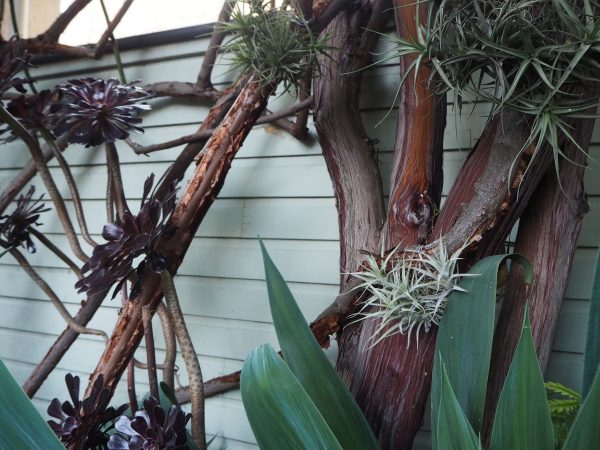
The Santa Cruz Ironwood tree (Lyonothamnus floribundus) has stretchy peeling bark – the blackbirds love to strip it off for their nests in spring. The airplants are attached.
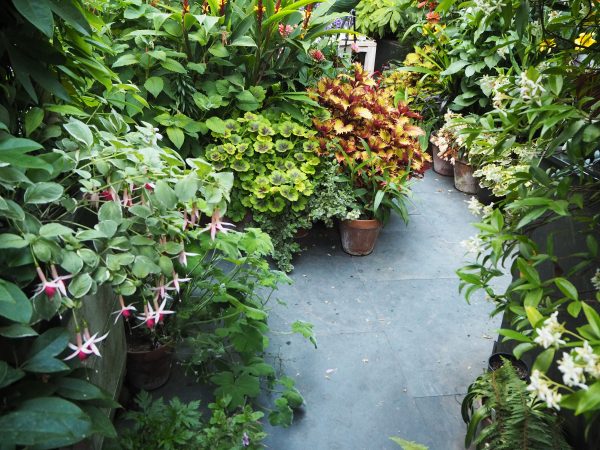
It’s a small garden and most of the plants are in pots. Dan’s tall large leafed plants make the area feel private.
His theme is broadly ‘exotic gardening’ – definitely one of today’s hot new trends. (There’s advice on creating an exotic garden in a cool climate and an unusual tropical garden, also in Kent, in previous posts.)
How to install an outdoor kitchen
Dan has a basement kitchen. Having people round meant a lot of going up and down stairs during the evening. He also works as a buyer for John Lewis, with a four hour daily commute, so entertaining needs to be as relaxing as possible. The solution was to build an ‘outdoor kitchen’ in the garden for entertaining.
He prepares food beforehand in the main house kitchen, and cooks on the built-in barbecue/hob in the garden. There is also a sink, worksurface area and some storage.

Dan’s outdoor kitchen makes a big difference to entertaining. Note the small ‘splashback’ between the slate tiles and the base of the kitchen units. The dahlia on the left is called ‘Firepot.’
‘Make sure that you use good quality tanalised wood for an outdoor kitchen,’ advises Dan. ‘My kitchen isn’t under cover, so it gets rained on, snowed on and is hot in the summer. However, because I used the right wood, it has lasted for ten years.’
‘But don’t let the wood touch the ground directly, or it will rot. I’ve created something like a splashback in slate at the base so that water on the ground doesn’t rot the wood.’
He also advises you to minimise the number of joins on your outdoor kitchen work surface. ‘We started off using the same slate tiles as we had on the ground, but the joins all leaked. Now I have a piece of granite with just one join and there are no leaks. A kitchen unit outside will swell and shrink as the weather changes – it’s quite different from a kitchen inside. So it’s easy for cracks to appear.’

A view of the outdoor kitchen from above. The worksurface is granite and there is only one join. You can just see it on the top right hand side of the picture.
Marine-grade stainless steel
It’s also essential for any metal in outdoor kitchen equipment – the hob, barbecue and even the taps – to be of marine grade steel, so that they can survive the weather, including Broadstairs’ salt air.

A collection of exotic plants near the sink. Even the tap is of marine grade steel.
Plants in a garden for entertaining
We’ve already mentioned evergreen shrubs and trees for privacy and shelter. Dan also likes scented plants. A splendid Star Jasmine (Trachelospermum jasminoides) welcomes visitors at the gate, perfuming the air in summer and creating an evergreen wall the whole year round.
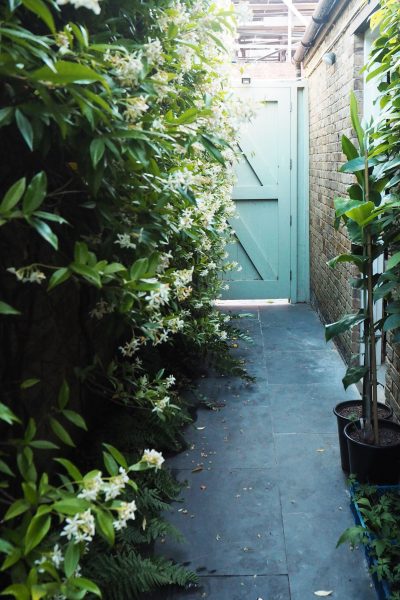
Star jasmine (Trachelospermum jasminoides) covers a wall at the entrance to Dan’s garden, greeting visitors with its rich scent.
Having unusual and exotic plants also creates interest.

Ginger lily (Hedychium) – Dan hopes it will still be around for the open gardens day on the 4th and 5th August
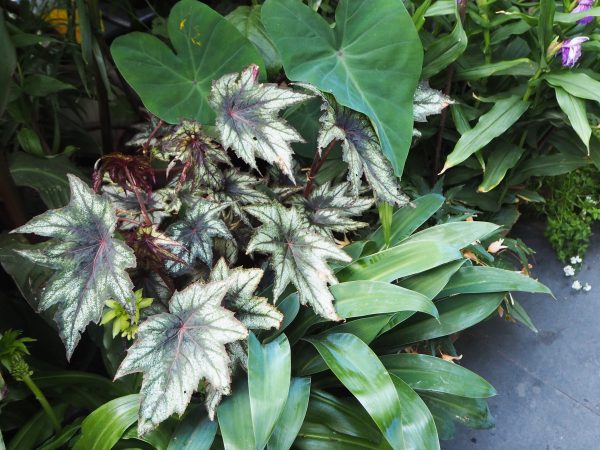
Guests always ask after interesting plants, such as this variegated leaf Begonia.
Furniture in a garden for entertaining
Dan has a table made of recycled oak, so it will go more silvery with age. He’s also chosen light, easy-to-wash, arm-free chairs, which tuck neatly under the table. Big garden chairs with arms would have taken up much more space.

Recycled oak table and light, easy to clean chairs which tuck under the table and save space.
Fridge or no fridge?
Dan decided not to have a fridge in the outdoor kitchen, but he does have a sheltered spot on the worksurface where an ice-bucket can sit.

A shady spot is very useful for storing an ice bucket and cold drinks.
See more of Dan’s garden on video:
Dan Cooper’s garden is open for the NGS on August 4th and 5th 2018. Or catch up with him on the Frustrated Gardener blog or YouTube channel, Twitter or Instagram
And we’ve somewhat neglected the Gin-and-tonic garden, so here’s a shot of it:

A close-up of Rosa ‘Dublin Bay’ and the Clematis ‘Forever Friends’.
And if you visit Broadstairs, don’t miss…
Don’t miss an ice-cream or an ice-cream sundae at Morelli’s, the traditional ice-cream parlour on the sea front. We treated ourselves to an evening swim and then had a Salted Caramel Nut Sundae. A heavenly way to round off a delightful evening.

You can just about justify this if you’ve had a swim in Viking Bay, Broadstairs, first.
Pin for reference:

The post How to create a garden for entertaining appeared first on The Middle-Sized Garden.
from The Middle-Sized Garden https://www.themiddlesizedgarden.co.uk/how-to-create-a-garden-for-entertaining/


